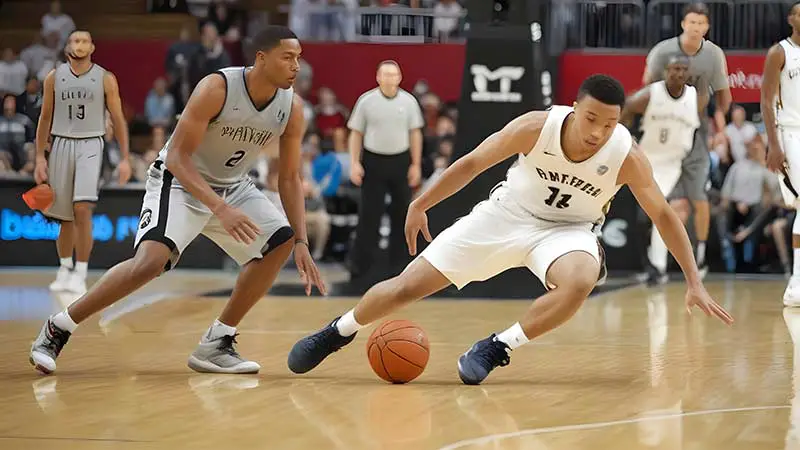Ever found yourself watching a basketball game and wondered if players can use their feet too? It’s not soccer, but sometimes that ball just begs to be kicked, right? Let’s dive into the nitty-gritty of basketball rules and see if your feet can get in on the action.
You might think a sneaky kick could be the perfect defense against a pass, but basketball has some pretty clear guidelines about what’s fair play. Intentionally kicking the ball or striking it with any part of the leg is a violation.
This rule is there to keep the game fair and consistent. The official rule states that an intentional kick results in a turnover or stoppage of play, giving the opposing team possession. If the kick is unintentional, the play generally continues.
Understanding this rule is essential for both players and fans to fully grasp how the game maintains its flow and integrity.
Overview of the Kicked Ball Rule in Basketball
In basketball, the “kicked ball” rule pertains to any deliberate use of the leg or foot to move or control the basketball. Here are the key points of the rule:
Definition and Purpose
The Kicked Ball Rule in basketball refers to intentionally striking the ball with any part of the leg or foot. If any player, offensive or defensive, deliberately kicks the ball, it’s considered a violation.
This rule ensures that the game remains focused on hand-eye coordination, which is integral to basketball.
The purpose of this rule is to maintain fair play and consistency on the court. Unintentional contact with the legs or feet does not constitute a violation. By enforcing this rule, the sport minimizes disruptions and keeps the gameplay fluid.
Rule Variations Across Leagues
Different basketball leagues may interpret and enforce the kicked ball rule differently, but the fundamental principle remains the same: intentional contact with the ball using the legs or feet is prohibited.
In the NBA, Rule 10 Section IV defines any intentional strike with the leg or foot, by offense or defense, as a violation, including using feet or legs to secure the ball during a loose ball situation.
This rule helps maintain fair gameplay by ensuring players rely on their hand skills instead of gaining an unfair advantage with their legs or feet.
Common Misconceptions About the Kicked Ball Rule
The “kicked ball” rule in basketball is often misunderstood. Here are some common misconceptions:
Intention vs. Accidental Kicking
Many believe that all contact between the ball and a player’s leg results in a violation. In reality, intentional kicking is penalized, not accidental contact.
If a defender, for example, inadvertently contacts the ball with their leg during a scramble, officials won’t call a violation.
This distinction aims to maintain the flow of the game while preventing players from using their legs to gain an unfair advantage. Knowing this distinction lets you better understand the calls made during a game.
Impact on Game Play and Strategy
People often think the Kicked Ball Rule has minimal effect on gameplay and strategy. However, this rule can influence offensive and defensive strategies significantly. Defenders aware of the rule will avoid using their feet to stop passes, changing how they position themselves.
For offenses, knowing defenders can’t legally kick the ball, they may employ low, quick passes to exploit this limitation. Understanding the rule can add a layer of strategy to both playing and watching the game, debunking the misconception that it’s a minor aspect of basketball.
How Officials Enforce the Kicked Ball Rule
Officials enforce the kicked ball rule in basketball by focusing on the intent and nature of the contact between the ball and the player’s leg or foot. Here are the key aspects of how they enforce this rule:
Criteria for Calling a Kicked Ball
Officials enforce the Kicked Ball Rule by identifying intentional acts involving the foot or leg and the ball. Intentional kicking includes deliberate actions to gain an advantage, such as striking, grabbing, or securing the ball with feet or legs.
Accidental contact doesn’t constitute a violation and is thus not penalized. For example, if a player unintentionally brushes the ball with their leg during a play, officials won’t call a kicked ball. Knowing this distinction ensures fair enforcement and avoids unwarranted penalties.
Challenges in Enforcement
Enforcing the Kicked Ball Rule presents challenges due to the subjective nature of determining intent. Officials must quickly assess whether the contact was deliberate or accidental, which can be difficult in fast-paced scenarios.
Misinterpretations can lead to contentious calls and disputes among players and fans. Additionally, players may exploit the rule’s nuances, making it harder for officials to maintain consistency.
Despite these challenges, thorough training and experience help refs make accurate judgments, thus ensuring fair gameplay.
Differences From Other Basketball Violations
The “kicked ball” rule in basketball differs from other basketball violations in several ways, mainly related to the nature of the violation, the intent behind it, and the resulting consequences. Here are the key differences:
Comparing to Traveling and Double Dribble
Traveling and double dribble violations differ significantly from the kicked ball rule. Traveling happens when a player takes too many steps without dribbling, and double dribble occurs when a player stops dribbling and then starts again or uses both hands.
Both rules ensure fair movement and integrity in dribbling. The kicked ball violation involves using the foot or leg to intentionally interact with the ball, focusing on lower body interference and maintaining consistent gameplay standards.
Interaction With the Shot Clock
The kicked ball rule affects the shot clock differently depending on which team commits the violation. If the defense commits the violation, the shot clock resets to fourteen seconds; if the offense does, the clock continues without a reset.
This rule influences team strategies, particularly in crucial game moments, by balancing offensive and defensive opportunities and helping teams plan their plays effectively.
Frequently Asked Questions
What is the Kicked Ball Rule in basketball?
The Kicked Ball Rule prohibits players from intentionally striking the ball with any part of the leg or foot to maintain fair play.
How do officials determine if a kick in basketball is intentional?
Officials judge the intent based on the player’s actions; it must be deliberate contact with the ball using the leg or foot to be considered a violation.
How does the Kicked Ball Rule differ from Traveling and Double Dribble violations?
While the Kicked Ball Rule addresses intentional contact with the ball using the leg or foot, Traveling concerns illegal player movement, and Double Dribble pertains to improper ball handling.
What happens to the shot clock when a kicked ball violation occurs?
For defensive kicked ball violations, the shot clock is reset to fourteen seconds to balance offensive and defensive opportunities.
How does the Kicked Ball Rule impact game strategy?
The rule affects both offensive and defensive strategies, as resetting the shot clock provides the offense with more time, influencing the planning of plays during critical game moments.
Conclusion
Understanding the Kicked Ball Rule is crucial for appreciating the intricacies of basketball. This rule not only ensures fair play but also adds a layer of strategy to the game.
By recognizing how it differs from other violations like Traveling and Double Dribble, you gain a deeper insight into the sport’s regulations. Additionally, the impact on the shot clock can significantly influence game dynamics, making every second count.
Mastering these nuances enhances your overall enjoyment and knowledge of basketball, whether you’re playing, coaching, or just watching. Knowing the Kicked Ball Rule also aids in better interpreting referees’ decisions during crucial moments.
This understanding can be pivotal during high-stakes matches, where each call can shift momentum.








Buzz Williams